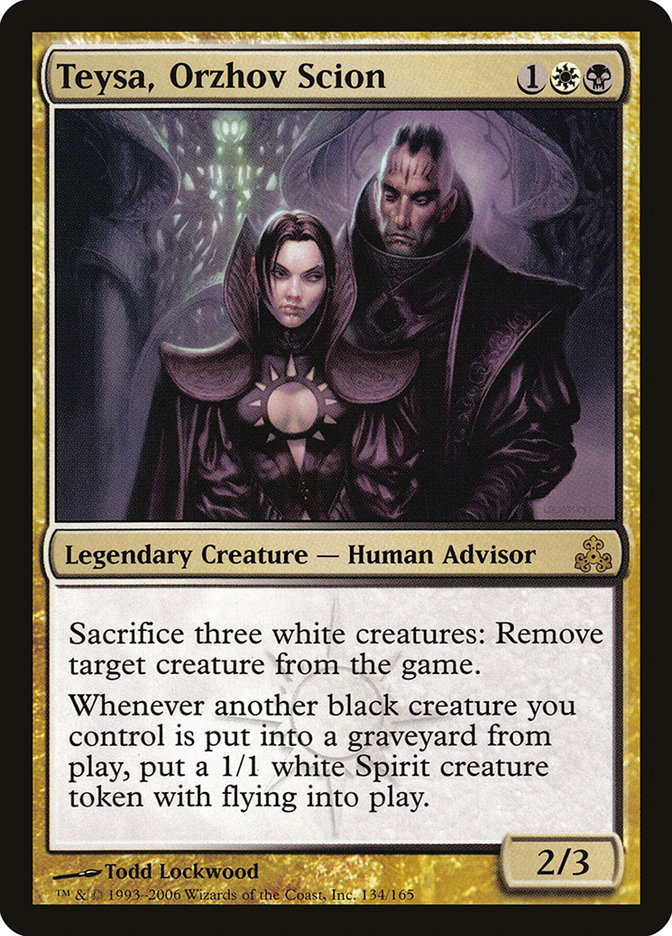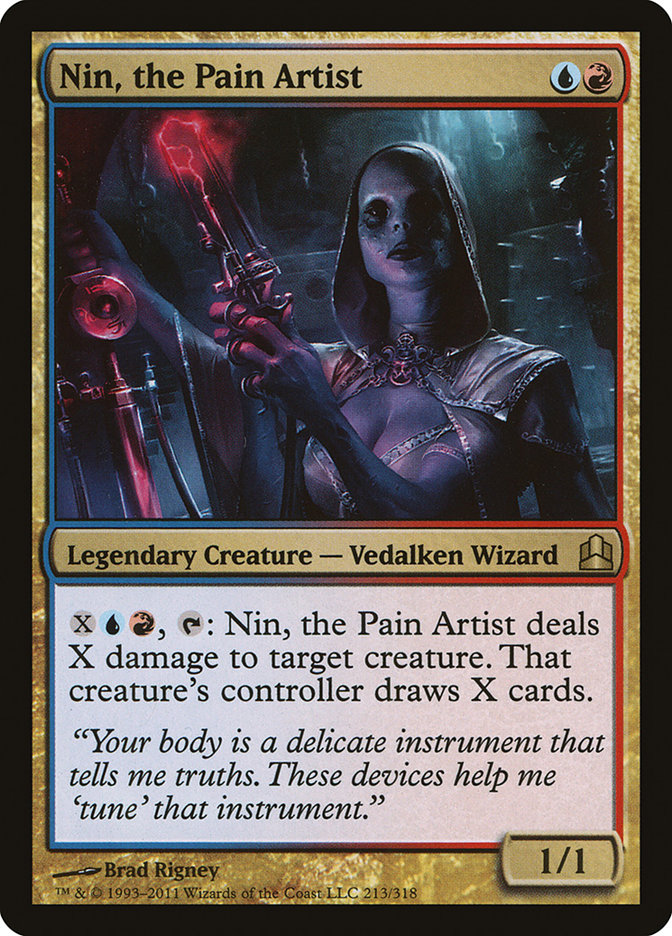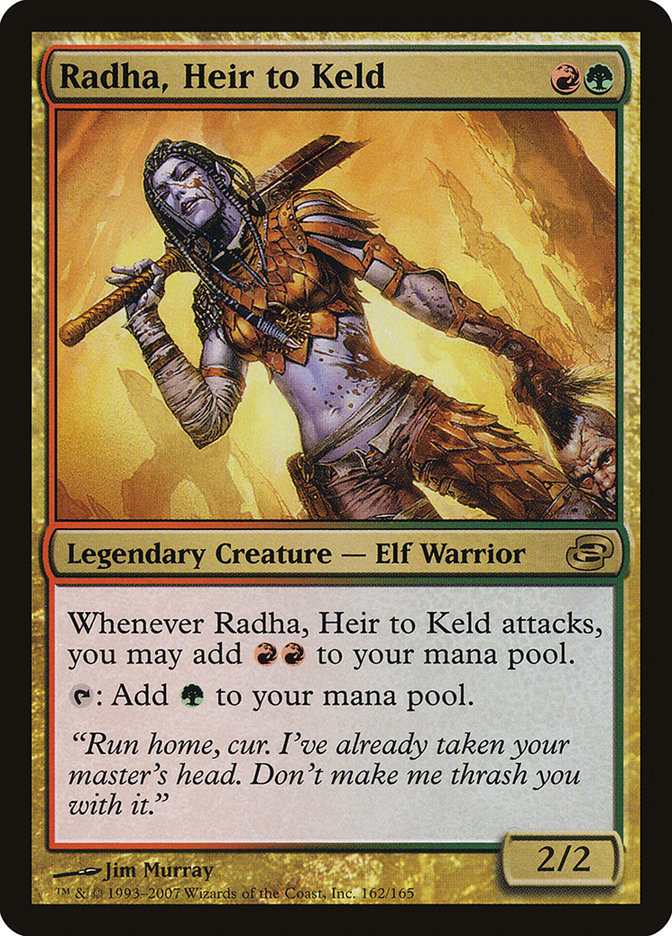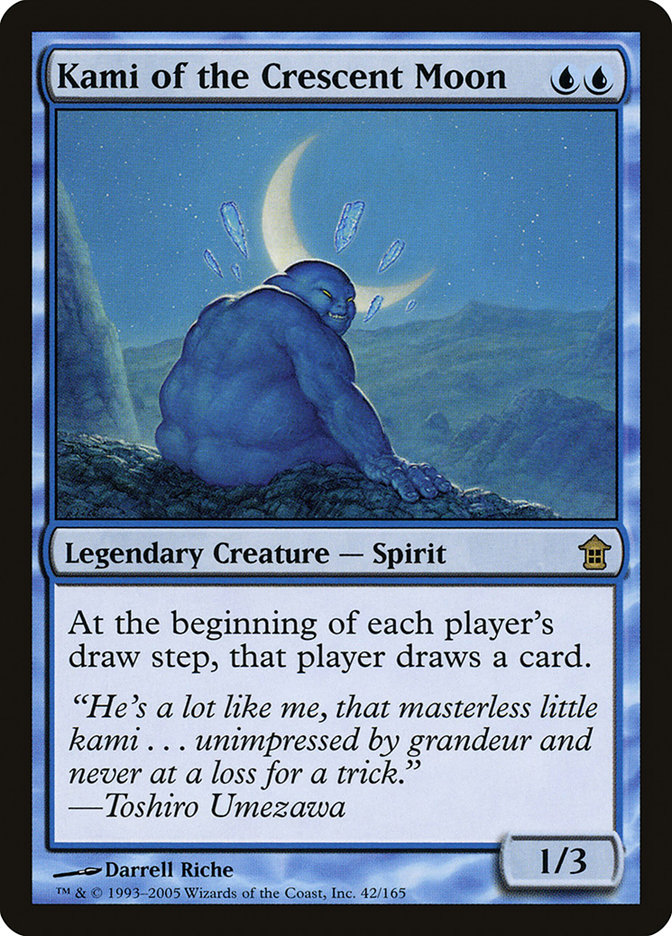I’m really excited about this week. Among other things, the year 2014 is drawing to a close, and we all get a chance to look back on our personal,
professional, and Magic-oriented lives and see where we’ve come from–some of these elements might even have been interwoven! For me, I pushed through the
meat of my MBA in 2014, and in four short months, I’ll get to add those letters to my work e-mail signature. I got a chance to travel to seven different
countries, and I’ve started a photography and observational blog documenting my local and regional travel, much of which is done on foot. My wife and I
celebrated five years of marriage together, and I’ve loved every day of it. I’ve written 52 articles of Magic this year, celebrated my hundredth article,
and I’m still fired up about Magic. Standard is in a healthy place, is growing, and Fate Reforged previews started yesterday.
Although there’ll be plenty of time to talk about Fate Reforged, I want to share something today that’s truly new.
This article isn’t about Standard, Modern, or Legacy. It’s about Commander. Well, sort of.
What do these cards have in common?
They’re legendary and they cost three mana or less. Seems pretty irrelevant, right? Lucky for us, a Canadian fellow thought up a clever way to make it
matter, and it has a fun name: Tiny Leaders. Bramwell Tackaberry made the format up last year and has been testing it locally and internationally since. I
heard about the format a few weeks ago from a shop across the Ohio, but since then, it’s been spreading like wildfire in Louisville proper, and we’ve
already hosted a couple events to test this nascent format.
Personally, I prefer the name “Halfamander,” but there you go…
Tiny Leaders, as Bramwell and the community call it, is a Commander-based format that challenges the very ethos of Commander: big, flashy spells that all
have that “must-answer” quality. Instead of swinging around massive spells in battlecruiser Magic, what would it be like to implement Commander rules on a
small scale?
In short, Tiny Leaders is a format similar to, but ultimately distinct from Commander; you choose a Commander, build around his, her, or its color
identity, and try to defeat your opponent with your creatures and spells or through “Commander damage.”
Here’s a crash course in Tiny Leaders, with a bit of a Commander refresher for those out of the know:
- Tiny Leaders decks contain exactly FIFTY cards, which includes your Commander (so, 49 + 1.)
-
Tiny Leaders, like Commander, implements the “singleton” or “Highlander” rule, meaning you can have only one copy of every card you use,
except for basic lands. -
Every card in Tiny Leaders must have a converted mana cost of three or less. Cards with “X” in the cost are legal only if the non-X cost
is three or less, e.g. Fireball is legal, but Brightflame is not. -
Just like Commander, your commander starts in the command zone, can be cast as if it was in your hand, and if it would die or be exiled, can return to
the command zone at your option, where it will cost two more to cast for each time it’s been cast from the command zone that game. Similarly, “Commander
damage,” combat damage dealt to your opponent by your commander, is tracked, and if you’ve been dealt 21 damage or more by any one general, you lose
regardless of your life total. -
Also like Commander, your deck may only contain cards that share colors with your commander, or colorless cards. Anything outside of your commander’s
color identity, whether it’s hybrid or contains mana symbols in its text outside of your color combination, cannot be used. - Tiny Leaders has its own banlist, which can be found here.
- You have 25 life.
-
Tiny Leaders players may utilize a ten-card sideboard, which must not contain cards with the same name as any in the maindeck, except
basic lands.
The last rule might seem unusual for Commander, but Tiny Leaders is different. Instead of having four, five, or ten players in Commander combat, Tiny
Leaders is specifically designed for one-on-one melee action. A couple people I know have compared it to Singleton Legacy, a fringe casual format that we
kitchen-tablers just called “anything goes” in my college dorm.
So it’s Commander, but not. It’s Legacy, but without the consistency of playsets. Seems like a wacky good time!
At present, by my estimation, there are about 110 legal commanders for Tiny Leaders that are available for use. Almost every two- and three-color
combination is available with a few exceptions. Three “wedges,” i.e. Khans clans, Mardu, Jeskai, and Sultai, do not have a commander within these
parameters. If you still want to use those wedges, you may “pretend” by using a generic commander proxy that costs one of each wedge color and is a vanilla
2/2.
You can find all the information you need to know about the format and its specific banlist at tinyleaders.blogspot.com;
this site is actively maintained by the creator and the testing community, so it’s always up-to-date and is very informative too.
“Well, that’s great and all, but I could have gone to that website and read all this. What’s in it for me?”
I’m glad you asked, Imaginary Grumpy Reader. Tiny Leaders brings two different playstyles together to create a distinct experience that’s fun,
skill-oriented, and is filled with room for growth and innovation. Although it is a gross generalization, hardened Legacy players scoff at
Commander’s validation of terrible spells and inconsistency, while casual Commander players find Legacy intimidating and uninviting. This allows both
players to experience a new format where they can all have a good time.
With a small Commander pool, it’s easier for prominent strategies to develop, and although I’m disconnected from the “metagame” to some degree, that’s just
fine with me.
When I first heard about the format, as many people do when considering a format for the first time, I considered aggro. One general in particular stood
out as flexible and aggressive.
Radha had the multicolored aspect to her, the easy mana activation, and the potential for pain that I liked to start my journey into the format. While
other people were talking about infinite combos and porting Legacy decks into the format, I was worried about smashing duders together.
After significant revisions and consideration, Radha became the first list I finished for
Halfamander
Tiny Leaders.
Creatures (16)
- 1 Birds of Paradise
- 1 Caller of the Claw
- 1 Burning-Tree Shaman
- 1 Scab-Clan Mauler
- 1 Radha, Heir to Keld
- 1 Boggart Ram-Gang
- 1 Kiln Fiend
- 1 Chandra's Phoenix
- 1 Burning-Tree Emissary
- 1 Pyrewild Shaman
- 1 Zhur-Taa Druid
- 1 Elvish Mystic
- 1 Young Pyromancer
- 1 Boon Satyr
- 1 Monastery Swiftspear
- 1 Dualcaster Mage
Planeswalkers (1)
Lands (17)
Spells (16)

In my mind, Radha had a lot of tempo potential between smashing creatures and smashing your opponent’s face to keep you in the driver’s seat.
While it’s impossible to take the time to go over each choice, the creature base has several facets. There’s a handful of mana producers to make you
efficient; you want to cast creatures and spells each turn, and keeping dorks untapped helps push things along. Zhur-Taa Druid is a bit of a clock
itself, and Burning-Tree Emissary helps you get ahead of what your opponent’s doing. Remember, there’s no Wrath of God, Mutilate, or Supreme Verdict to
blow you out! There are creatures you care about spells being cast, like Monastery Swiftspear, Kiln Fiend, and Young Pyromancer. Monastery Swiftspear is
really just a little bitty Kiln Fiend, and without the option of playsets, redundancy is key in a fast deck. Some creatures work directly with Radha’s
trigger. Pyrewild Shaman’s bloodthirst can be used for no cost, and you can easily pay to recover it, if you want. Boon Satyr can be bestowed for just 1GG
after the trigger, making a measly 2/2 a monster. Dualcaster Mage, a newbie from Commander 2014, fits the Tiny Leaders restriction well and can amplify any
combat trick or burn spell either you or your opponent add to the stack.
The spell suite is oriented to one-time damage. Searing Blood is a particularly exciting and modern edition, able to be used directly off Radha’s trigger,
as is Psychotic Fury. With just a couple pump spells, the Fury can put your opponent down in one combat through Commander damage. Clan Defiance and Savage
Twister, both of which sneak under the three-or-less radar, can splatter a board thanks to your mana dorks, and cards like Violent Outburst are pure value,
granting at least one other spell. Even the noncreature permanents play critical roles; Rancor is a must in a deck with pump spells, and Fires of Yavimaya
keeps your topdecks strong. Domri Rade is never bad, and in this format, only a few planeswalkers slide under the limbo bar.
The lands are mostly mana fixers, but gems like Kessig Wolf Run can be vicious in the lategame. I’m not sure about the basic land balance, but with so many
dual-color producers, I’m not sure it matters either.
The sideboard might include cards like Guttural Response, Vexing Shusher, and other anti-blue cards, as well as enchantment and artifact removal to keep
those pesky Equipments and Auras at bay. In this format with generally weak creatures, these noncreature permanents make up the gap.
So the aggressive, attack-on-all-sides route is one line, but what if we decided to take our time and build a single massive threat through synergy and
efficiency?
If that sounds like a better plan, you’d be kitten yourself if you said you didn’t like this list.
Creatures (16)
- 1 Leonin Shikari
- 1 Auriok Steelshaper
- 1 Whitemane Lion
- 1 Kor Duelist
- 1 Stoneforge Mystic
- 1 Student of Warfare
- 1 Serra Ascendant
- 1 Kemba, Kha Regent
- 1 Leonin Arbiter
- 1 Etched Champion
- 1 Auriok Edgewright
- 1 Mirran Crusader
- 1 Leonin Relic-Warder
- 1 Puresteel Paladin
- 1 Ajani's Sunstriker
- 1 Brimaz, King of Oreskos
Planeswalkers (1)
Lands (16)
Spells (17)
- 1 Swords to Plowshares
- 1 Konda's Banner
- 1 Bonesplitter
- 1 Sword of Light and Shadow
- 1 Sword of Fire and Ice
- 1 Loxodon Warhammer
- 1 Lightning Greaves
- 1 Steelshaper's Gift
- 1 Brave the Elements
- 1 Emerge Unscathed
- 1 Sword of Feast and Famine
- 1 White Sun's Zenith
- 1 Mortarpod
- 1 Dispatch
- 1 Swiftfoot Boots
- 1 Spear of Heliod
- 1 Masterwork of Ingenuity

Kemba is a common choice for this format I’m told, but I decided to take a whack at it anyway. Kemba loves equipment, so I packed the deck full of
synergetic creatures, equipment, and ways to make the two card types meet. This one has a heftier price tag than the Radha list, with several hard-to-find
equipment floating around in there. Sadly, three of my favorite Equipment, Umezawa’s Jitte, Sword of Body and Mind, and Skullclamp were proudly featured on
the banlist, limiting the power level a bit.
Some creatures are essential to the strategy. Stoneforge Mystic and Puresteel Paladin work amazingly together, and protecting the Paladin is critical to
keeping your play flexible. Similarly, Leonin Shikari lets you equip instantly, and with three swords offering colored protection, this is a great way to
fake not having a protection spell. You’ll notice there’s a strong Cat theme, and that’s just not just a flavor choice. Konda’s Banner, when equipped to
our commander, grants all white Cats a +2/+2 bonus, making even the lowliest Sanctuary Cat a ferocious feline. Similarly, Auriok Steelshaper helps the
Soldiers and Knights in the list shine.
The equipment are the best ones the banlist didn’t prohibit. From the efficient and hassle-free Bonesplitter to the powerful Warhammer, you’ll always have
the right tools. The spells are mostly defensive spells designed to protect your card and mana investment, particularly in response to an equip. White
Sun’s Zenith is cat-astrophic on an empty board. Ajani, Caller of Pride, is another planeswalker that makes the cut. Spear of Heliod, as opposed to
Crusade, Honor of the Pure, or even Glorious Anthem, is an artifact, assisting with the metalcraft requirement of some of the deck’s components.
This list promises to be sturdy and fearsome in combat. I love suiting up equipments, but the cost of this list was steep for just entering an admittedly
(thus far) fringe format.
Lastly, I bring you my current pride and joy, the only one I’ve tested, the only with a sideboard, and the only one…with my heart. No combat; no killing.
Just silently milling, milling you away.
Creatures (12)
- 1 Voidmage Prodigy
- 1 Patron Wizard
- 1 Vedalken Mastermind
- 1 Kami of the Crescent Moon
- 1 Martyr of Frost
- 1 Vendilion Clique
- 1 Drowner Initiate
- 1 Jace's Archivist
- 1 Phantasmal Image
- 1 Snapcaster Mage
- 1 Augur of Bolas
- 1 Thassa, God of the Sea
Lands (20)
Spells (18)

Now that’s more like it!
This Wizard-themed brew takes the oft-despised tribe into new territory, playing defense while I assemble a game-winning mill spell. The opponent draws and
draws until, one turn, they have no library left at all.
Besides my Spirit Commander, every creature, maindeck and sideboard, is a Wizard, and most are heavily so. The only exception, Thassa, is the best blocker
for three mana blue can buy. Patron Wizard can tap every Wizard to help keep spells off the table and is arguably one of the best creatures in the deck.
Jace’s Archivist puts your milling in high gear, milling both you and your opponent’s full grips. Vedalken Mastermind can bounce a land, blocker, or
enchantment to gain its effect again. Snapcaster Mage, particularly useful in a low-cost deck, can swoop in and rebuy anything you’ve cast. Even Vendilion
Clique, a contender for the commander position, can be mighty powerful at the end of turn.
The spell set is pretty straightforward and familiar to most Eternal players. Sanity Grinding is one of only a few dedicated milling spells that remains in
the deck after significant testing. With cards sporting multiple blue mana symbols, Sanity Grinding can mill a large portion of your opponent’s library for
just three mana. Increasing Confusion, when cast both times, does a similar job.
The noncreature permanents, though few, contribute significantly to the deck’s success. Propaganda gives this deck precious time; 25 life goes away pretty
quick. Agoraphobia is a quick answer that can also return itself once it’s provided its usefulness. Threads of Disloyalty, a slightly pricey but powerful
enchantment, can snag some of the format’s best creatures. Even Carry Away, a niche card if I ever saw one, shines in a world with protective equipment.
The deck is very heavily blue, so the deck’s mana had to accommodate, with all but two lands able to produce blue mana (though some more directly than
others.) Nykthos, Shrine to Nyx is one of the deck’s best lands, producing immense amounts of blue mana on a regular basis. Tolaria West finds any other
land, whether it’s Maze of Ith, Vesuva, or even Dust Bowl, designed to take out the other player’s Boseiju, Who Shelters All or Cavern of Souls.
In testing, this deck has been able to pull out wins against much more capable decks. Starting with a free Glimpse the Unthinkable (50-card decks) gives
milling a particularly attractive profile in the metagame. With some practice, Kami of the Crescent Moon, or at least the mill plan, might be a prominent
choice.
This format is full of viable strategies and configurations, and building a deck to match your style is just as fun as trying it out. You can make
them serious decks or just for fun, and I’m trying to bridge the gap with Kami of the Crescent Moon.
Thank you all for your comments and discussion this year; it’s been a pleasure to share 2014 in the world of Magic with every one of you. If you find
yourself interested in the travel blog I mentioned earlier, feel free to check it out at www.milesbyfoot.com, where I
post every Wednesday, or on Tumblr at milesbyfoot.tumblr.com.
Have a happy New Year, and I’ll see you on the other side with more Fate Reforged previews! Until then, where does the Tiny Leaders format lead you?






